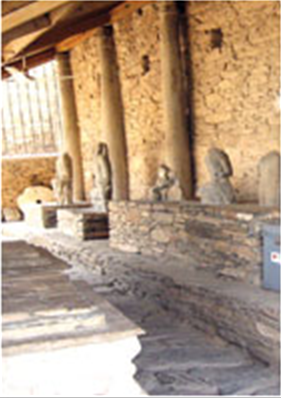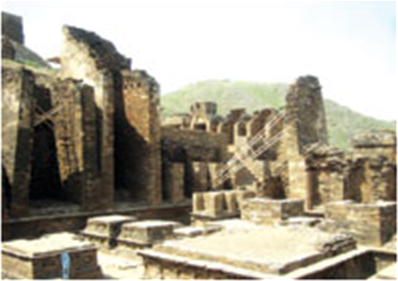Mardan: Takht-i-Bahi
This is a collection of articles archived for the excellence of their content. Readers will be able to edit existing articles and post new articles directly |
Mardan: Takht-i-Bahi
Magnificent Buddhist remains
By Tahir Ali
The North Western Frontier Province (NWFP) has been lavishly bestowed with various precious resources. It has plenty of water and a big power generation capacity, snow covered mountains, thick forests, gas reservoirs, vast gemstone deposits and other minerals. The presence of archaeological sites in Mardan, Swat and other areas adds further charm to its pristine beauty.
Mardan, the Frontier’s second largest city, is called ‘the land of Gandhara’ as it was the heart of the ancient civilisation. Several remains of the civilisation can be seen at Takht-i-Bahi, Sehri Bahlol, Shahbaz Garhi, Jamal Garhi, Sawal Dher, Mekha Sanda, Chanakai Dheri, and Aziz Dheri.
The Takht-i-Bahi archaeological site is one of the most magnificent of Buddhist remains in Pakistan. It is situated on the Mardan-Swat road some 13km north of the city. The complex is accessible from Islamabad by a two-hour drive while from Peshawar it is some 80km away and is accessible in about an hour — thanks to the Islamabad-Peshawar motorway.
Located 2km east of Takht-i-Bahi bazaar, this Buddhist complex stands 500 feet above the ground and is built on a hilltop, as is common with all Buddhist structures.
As you go up the mountain you get a spectacular panoramic view of the plains in the east, south and west. Even more refreshing is the sight northwards of the beautiful Malakand pass and the Hindu Kush mountainous range.
The monastery and the near by village, some say, have been named after the two wells located on top of the hill that the complex is situated on. Others think Takht means ‘throne’ and Bahi or Bhai stands for ‘water’ or ‘spring’ in Persian. There is still a spring of fresh water present on the left side of this Buddhist site.
General Court, the French officer of Maharaja Ranjit Singh, first mentioned the site in 1836. Later it was explored in 1852, 1864, and 1869-70. General Maclagan’s deputed men found several sculptures here afterwards. Sergeant Wilcher of the company Sappers and Miners excavated it in 1871 and found innumerable sculptures — some of these depicted stories from the life of Buddha, while others were related to worship.
In 1907-8, the curator of Peshawar Museum, Dr DB Spooner systematically excavated the site. Later, in 1910-11, Mr Hargreaves, another curator, discovered the famous and beautiful thin Siddhartha in three parts. A large number of stone and stucco sculptures have been excavated since then which are now on display in Peshawar and Mardan museums. Many, however, were wasted due to recklessness of excavators or were stolen.
According to some historians, the Takht-i-Bahi monastery was destroyed by the Huns of Central Asia along with many other Gandhara sites in the region. Their king Mihiragula, according to an account, destroyed 1600 stupas, monasteries and killed two thirds of Gandhara’s inhabitants and this complex also suffered heavily as a result.
According to some historians, the Takht-i-Bahi monastery was destroyed by the Huns of Central Asia along with many other Gandhara sites in the region.
Until 2001, only about 15% area of the whole site was exposed. In 2004-5, the department of archaeology discovered a huge-block on the western and southwestern sides of the site, which added new charm to it. Some famous statues of Buddha and Gandhara art pieces were excavated. The newly discovered part is many times bigger than the one previously exposed.
The site presents architectural diversity and beauty combined. It dates back to 2nd century BC and has a covered area of 650 canals. It comprises the main stupa and votive stupa courts, the kitchens and dinning hall, meditation cells, monastic quadrangle, covered underground passages, the monastery, conference hall, the low-level chambers, open courtyard, the court of three stupas, remains of hundreds of rooms and prison cells.
There is a small museum where a few statues and relics are displayed. The court of stupas, experts say, contained statues of Buddha in sitting and standing postures but were removed later. A statue of the Buddha is on display in the centre of the complex. The sight of the sculpture reminded me of my earlier visit here in 1995 when almost each stupa had statues in it. An official informed me that some of them are now either kept in Peshawar or in a safe location within the complex.
Walking around, you cannot help but wonder about the acumen of the architects of this complex. You can see that the monastery had cells for the monks on four sides, a veranda in front, and assembly hall and storerooms which gives an idea about the lifestyle of the monks.
There is plenty to explore here. Going down into the meditation rooms, you enter the various cells. The underground passage between the eastern and western and the central and western sections of the monastery atop the hill to the south are no less interesting.
Due to its historical significance and amazing architectural features, UNESCO has placed the site on its ‘World heritage list’. The Sahri-Bahlol remains that date back to the same period and are located a couple of kilometres away to its south, have also been awarded the status.
Zulfiqar Ali, a teacher who had come here with his students, told this writer that despite the fact that huge funds have been spent to attract visitors, still tourist facilities like cafeteria, tuck shop, and tourist information are not available. Another visitor felt annoyed that Takht-i-Bahi municipal committee was dropping garbage collected from the city near the site. Naveed, 30, a visitor from Mardan underlined the need for stopping illegal excavation and hill cutting near the site, arguing that it posed potential threat to the remains.
A few site attendants guide and facilitate the tourists as well as look after the site. One of them, Amjad Ali, told this writer that he was proud to be looking after this magnificent structure. He informed that tourists were on the decline since 9/11.
Major repair work at the site started in 2001 though it had been initiated by the British before partition. At present, the second five-year phase of repair work is underway. But several parts are on the verge of collapse and are being supported with iron bars to hold them up. However, more attention on the part of the federal and NWFP governments and UNESCO is needed for the conservation and restoration of this precious and rare remain site as well as others in the area. It remains to be seen if they will come to its rescue before it is too late.
Above: Some brooken statues on display at the site Left: A view of the Takht-i-Bahi complex Below: Another view of the complex with one section supported to guard against collapse Bottom left: The central part of the complexPeshawar?



